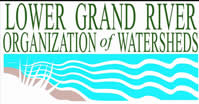Lower Grand Watershed Interactive Tool (WIT) - Salts

Salts are chemical compounds from winter road de-icing, septic systems, and water softener outwash.
What is it? (1)
"Salt is composed of sodium and chloride, and occurs naturally in soil and water. Surface water runoff and groundwater infiltration from precipitation and irrigation can cause salts to dissolve from the soil and contaminate surface and groundwater supplies."
Why is Salt Harmful? (2)
"Salinity (the presence of excess salts in water) can be harmful to certain plants, aquatic species, and humans. High levels of salt in drinking water can lead to high blood pressure and other health concerns for humans."
Salt levels are increased when hard water is softened by using salt. In our area river and well water is harder than the drinking water supplied by Lake Michigan. The calcium that is removed (to make water soft) is replaced by sodium. The sodium is now in the drinking water.
The irrigation of crops can leave unused water on the surface of soil. When the water evaporates salts are left behind. As they accumulate salinization occurs. This process can make land unusable for plant growth.
How is Excess Salt getting Into Water?
Road salt (rock salt) can be washed off roads by snowmelt. It can enter our streams and our irrigation systems. There are alternative methods starting to enter the market comprised of calcium carbonate or calcium acetate that aren't as detrimental to our water quality. It can also be picked up by water infiltrating through the soil by septic systems or from soil where water was applied after being processed by a water softening system.
Sources:
(1) Cech, Thomas V. 2003. Principles of Water Resources History, Development, Management, and Policy. John Wiley & Sons, Inc., U.S. pg 310. (2) Miller, G. Tyler Jr. 2001. Environmental Science 8th Edition. Brooks/Cole, Canada. pg 347.
